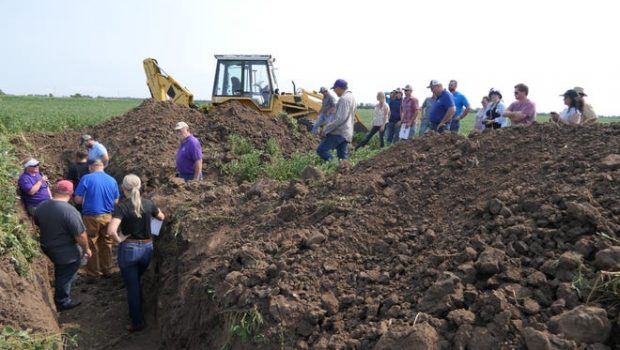Kansas farmers improve soil, aquifers with technology, no-till
Ray Flickner has a dream. A dream to heal the land and help others do the same.
Flickner owns Flickner Farms in McPherson County, just outside of Moundridge. He grows corn, sorghum and wheat and is introducing cover crops, trying to see if they can help with water retention and insect control.
Although this farmer wants to make his land more profitable and drought resilient, he is just as concerned that Kansans learn how to do the same. That's why he started Flickner Innovation Farm.
With the help of a multitude of irrigation, drone and imagery companies, a bunch of Kansas State University researchers and quite a few water conservationists, Flickner is using his land and his knowledge of farming to help others research and learn.
On Tuesday, he opened his farm to even more people — agronomists, farm extension agents and farmers — showing them what he has learned, from digging holes in the dirt to planting rye ahead of soybeans to using state-of-the-art drone technology and water filtration systems.
"The Lord gave me a lot of natural resources to manage," he said. "I'm trying to do the best I can with them."
Letting the plants drink
Ron Goering of R & E Goering Farms in McPherson County, who also uses state-of-the-art water technology on his farm, spoke of how water pivots are being used on Flickner Farms.
"We applied several technologies to this pivot," he said. "It has plant-based sensors."
The pivot runs over 118 acres in nine hours, using a variety of spigots, sensing devices and imagery collecting instruments.
Kansas State Extension agent Jonathan Aguilar, Ph.D., an irrigation engineer who works out of the K-State extension office in Garden City, explained that the plants prefer a drink of water to a soak.
Just one irrigation during the growing season can almost double the yield, he said. But after that, while watering is still helpful, the returns from each pass are not as high.
"We have a decreasing aquifer, so conservation is crucial," Flickner said.
Flying above crops on an unmanned drone
American Robotics' director of sales, Mike Burdick, whose Massachusetts-based company just received permission to fly unmanned drones without a human nearby, demonstrated how his red drone comes out of its box, examines the field — collecting data — and then flies home to its base.
"There's no human intervention all day," he said. "We continually monitor for any impediments."
By using drones, farmers can learn about their irrigation infrastructure and water distribution, Burdick said.
Trevor Witt of Kairos Geospatial in Abilene helps clients with viewing insects and is currently researching sorghum genetics in Colby with the help of unmanned aircraft systems.
"We are using drones in conservation work," Witt said. "They (UAS) are good at catching detail."
In addition to other technologies, K-State has planted a mobile weather station on the property. This is one of 75 stations across the state.
Cover crops are not quite what Flickner and the researchers expected
Along with no-till, Flickner is introducing cover crops. In one field of soybeans, he introduced rye and found this crop to help with weed control. K-State is on the ground, verifying what is working and what is not. He said for the most part they are working, but he said, he still needs to use some chemicals — at least for now.
"We want to work with something larger than small trial plots," said Peter Tomlinson, Ph.D., soil scientist and professor at K-State. "We are looking at how we can advance technology to soil management."
K-State is sending the results of these real-time soil moisture graphs from Flickner's fields to a research unit at North Carolina State University.
Tomlinson is using litterbags to catch soil samples and learn how much nitrogen is being released.
"We are looking into how to incorporate cover crop ahead of corn," Tomlinson said. "Visually, you don't see a lot of difference."
But, according to Tomlinson, because of the introduction of rye, there are fewer insects, better weed control, increased water penetration, and lower ground temperatures during summer months and higher ones during winter months.
"We see a lot more high and low temperatures (on the areas) without cover crops," Tomlinson said. "We know they are helping with extreme temperatures."
But even with cover crops, Sarah Lancaster, Ph.D., a weed management specialist at K-State, said soybeans, wheat and corn will still need a post-emergent herbicide.
"We're using all the good tools in the toolbox," Lancaster said. "Cover crops take pressure off the inventory of herbicides."
Howard Miller, the outreach coordinator of Cheney Lake Watershed, explained how a group of innovation farms are working with General Mills to help these farmers hone in on regenerative practices. It all started with a soil health academy the non-profit put on in 2019, Miller said.
"We like to see people learning from each other," he said. "Peer-to-peer is the best kind of education."








Gloss